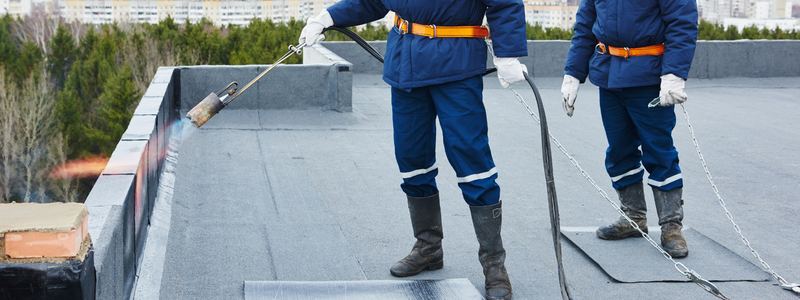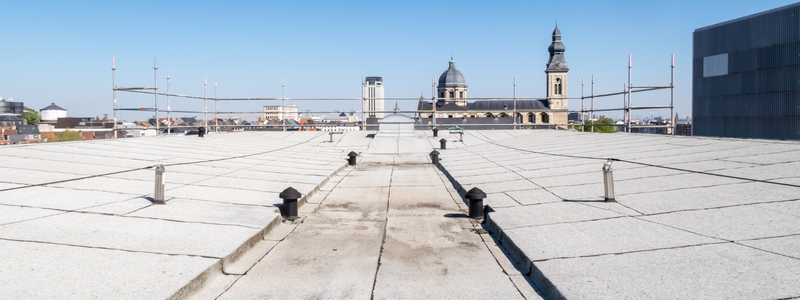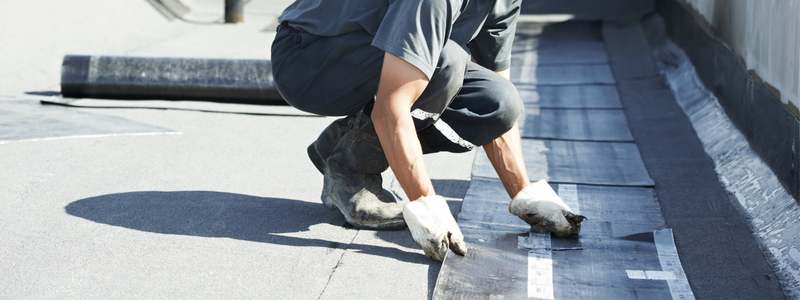
Types of Commercial Flat Roofs
Flat roofs are oftentimes seen on most commercial buildings because of their productivity and practical cost. The assortment of flat roofing options has developed considerably over the years. There are many types of commercial flat roofs available, but some options aren’t necessary for certain buildings.
With so many options available, it can be a little overwhelming and confusing to determine which commercial flat roof will work best for your building’s needs. You will most likely be dealing with these kinds of roofs if you’re the owner of a commercial building. Commercial flat roofs are a bit of a specialized area of expertise so it can be difficult to understand what you’re getting into, which is why we are here to help at B&M Roofing!

Although simple and utilitarian, the main goal of a roof system is to maintain the watertight integrity of a building and keep its contents dry.
What is a Commercial Flat Roof?
A commercial flat roof is a type of roof that is almost level or has a very slight pitch, usually less than 10 degrees. Unlike pitched roofs, which have a steep slope to allow water to run off, flat roofs are generally horizontal or have a slight slope to allow water to drain toward gutters and drains.
Commercial Flat Roof Components
Many modern businesses and even some residences have a commercial flat roof protecting them from the elements . Each commercial roof component serves its own specific purpose. The construction of commercial flat roofs follows three fundamental components:
- Weatherproofing: To keep the elements outside.
- Reinforcement: To provide structural integrity to the roof.
- Surfacing: To protect the rest of the roof from sunlight and weather.

Commercial Flat Roof Types
When it comes to choosing a commercial flat roofing material, there are several options available. Each material has its advantages and disadvantages, so it’s essential to consider your needs and budget before making a decision. Remember that no matter what type of roof you choose, you will need to maintain your commercial roof to keep it in good condition. Here are some common commercial flat roofing materials and their characteristics.
Built-Up Roofing (BUR):
- Also known as a tar-and-gravel roof, this is a traditional flat roofing system that uses layers of asphalt and roofing felt alternated with hot tar to create a durable and waterproof surface. These roofs are fire-resistant, low maintenance, and can last 20 years or more. These roofs don’t hold up as well as others to adverse weather conditions when compared with other types of commercial flat roofs.
Metal Roofing
- Metal roofing uses metal panels in place of shingles. The roofing panels are made from steel, aluminum, copper, or zinc. These roofs are durable and can last up to 50+ years, resistant to weather, are energy-efficient, require low maintenance, and are aesthetically pleasing. Metal roofing comes in a variety of styles and colors, and can be designed to match the style of the building. These roofs are more expensive than traditional roofing materials, tend to be noisier during storms, and their installation requires specialized equipment.
Thermoset EPDM Roof Membrane (EPDM)
- Thermoset EPDM roofing membranes are made from synthetic rubber and are commonly used as a roofing material for low-slope or flat roofs. The membrane is installed in large sheets glued or fastened to the roof deck. EPDM roofs can last 40+ years, are resistant to weathering, ultraviolet radiation, and ozone, they reflect heat and light, which helps to reduce cooling costs in the summer, and are low maintenance. EPDM roofing membranes are more expensive than other roofing materials, require specialized knowledge to install properly, and are at risk to punctures by sharp objects.
Thermoplastic Olefin (TPO) Roof:
- Thermoplastic Olefin, or TPO roofing, is a type of roofing material that is commonly used in commercial and industrial buildings. TPO is a single-ply roofing membrane made of a blend of plastic and rubber materials. The material is lightweight, flexible, and resistant to weathering, making it an ideal choice for flat or low-slope roofs. TPO roofs reflect heat and light, reducing cooling costs, reszist harsh weather, and installation is easy. This roof type is less expensive than some other roofing options, and is environmentally friendly and recyclable. This type of commercial roofing is vulnerable to punctures by sharp objects and exposure to extreme weather conditions. TPO roofs come in white or light colors.
Polyvinyl Chloride (PVC) Roof:
- PVC roofing a synthetic plastic polymer reinforced with polyester and fiberglass materials. The material is flexible, durable, and resistant to weathering, making it an ideal choice for flat or low-slope roofs. These types of commercial flat roofs reflect heat and light, are energy efficient, highly durable, fire-resistant, and are easily installed with heat-welded seams. This type of roof is typically more expensive than other roofing materials such as TPO or EPDM. Typically only available in white or light colors, these roofs can have negative environmental impacts due to its manufacturing process.
Spray Polyurethane Foam (SPF):
- SPF roofing is a combination of two liquid chemicals: polyol and isocyanate. The spraying of these chemicals onto the roof surface forms a seamless, waterproof layer. This type of roofing is a popular choice for commercial flat roofs due to its many benefits. SPF roofing has many advantages such as energy efficiency, durability, waterproofing, sustainability, and customization. These roofs provides excellent insulation, can last up to 50 years, are environmentally friendly. However, they require regular maintenance, and the chemicals used in SPF roofing can be hazardous if not handled properly.
Green Roofing
- Living roofing, also known as green roofing, is a roofing system that incorporates vegetation into the roof design. Green roofs offer several advantages, including environmental benefits such as reducing the urban heat island effect and providing natural habitats for wildlife, energy efficiency by providing insulation, aesthetic appeal with visually stunning exteriors, and longevity, lasting up to 40 years. Green roofs have higher installation and maintenance costs, potential to add weight to a building, and a risk of leaks.

B&M Roofing – Commercial Building Roof Design
B&M Roofing is a Colorado-based business with over seventy years of effective installations of many types of commercial flat roofs. We have gained notoriety for being quick, productive, and efficient in our work. We are proud to provide skilled roofing assistance to thousands of Coloradoans every year. No matter what kind of roofing services you may need, our team at B&M Roofing is happy to help!
We are here to help with your commercial flat roofing needs. Contact us today to set up services for your roof!




































